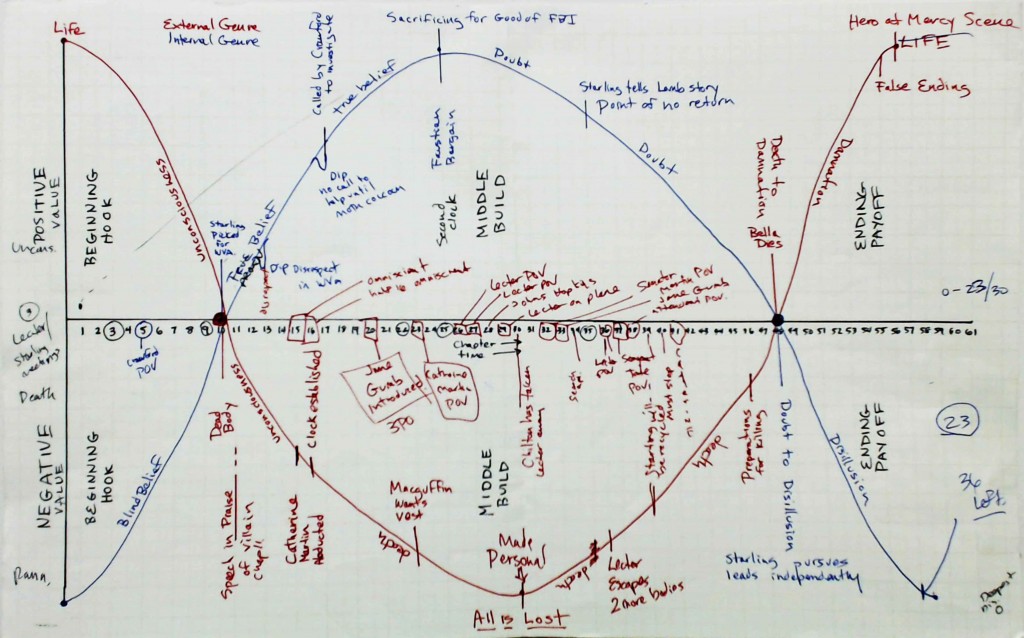Later on, I’ll go through it in excruciatingly exhaustive line by line detail, but for now it’s worth looking at the complete Foolscap Global Story Grid for The Silence of the Lambs. Here it is:
Just as a reminder, to put the Foolscap Global Story Grid in context, this one-pager gives the editor/writer the 30,000 foot view of the Story. It’s the MACRO STORY. It’s a wonderful way of making sure that the big picture is clear.
It is ONE of TWO indispensable documents necessary to create the final STORY GRID infographic, this fun thing below:
The second document that you will need to create is The Story Grid Spreadsheet. I will walk you through how to do that in a few weeks. The Story Grid Spreadsheet is a multi-pager that will give you the MICRO STORY.
But before we get into creating yet another grid that we will combine with the Foolscap Global Story Grid to create an infographic that we can stick on a wall and contemplate to our hearts content (Are you completely lost yet?), in the next series of posts, I’ll review the principles of UNIVERSAL STORY FORM (inciting incident, progressive complications, crisis, climax and resolution).
All of this stuff may seem complicated, but it’s really just a process in analyzing the MACRO movements of a Story, and then analyzing the MICRO movements of a Story, and then combining the MICRO and MACRO into a visual representation of how writers create art.
When we finish the editorial process, we’ll know exactly where (which scene, page, paragraph etc.) a writer satisfied the conventions and obligatory scenes of his/her chosen genre/s and a myriad of other bits of information that reveal the specific judgements and choices the writer made.
Knowing how Thomas Harris solved the “Macguffin” or “Hero at the Mercy of the Villain Scene” will inspire us in our own work. It just will.
Diving deeply into the great works of our beloved genre/s and coming up for air after we’ve created Story Grids to remind us of the craftsmanship of the writers who created them will prove immeasurably helpful when we set out to create our own works. And it will also give us a common language.
The more writers who take the time to learn how to Edit, the greater the ease we’ll have talking shop. There won’t be any more murky “suggestions” about “making your character more likable” or “adding more colors to your subtext.” No more Bullshit peer review of our work without our peers having a grounded understanding of the craft in the art.
Instead, one day, I hope that a frustrated writer of sea stories battling the coup de grace crisis in her ENDING PAYOFF will be able to send a single email to a group of her pals like this:
“What was the final external crisis in the ENDING PAYOFF of MOBY DICK?”
and get an answer like this:
“Best Bad Choice: Ahab must decide whether to let go of the harpoon rope attached to MD and save himself or hang on as the beast dives down into the depths and assures Ahab’s briny death.”
That’s how Melville solved the external crisis in his ending payoff. Placing yourself in his creative shoes regardless of the commercial results (MD was a commercial bomb in his lifetime, but a masterpiece today) is inspiring. Just knowing that Melville must have been tormented by the same story dilemmas we are is comforting.
Anyway, I know this stuff can get very “inside baseball.” When it does, take a deep breath and remember that there are two ways an editor looks at a Story, MACRO (big picture Foolscap) and MICRO (minutiae of Story Grid spreadsheet). Once he has a grasp of both, the editor’s complete vision/interpretation of a work is represented by his STORY GRID.
Next up is a review of Story Form…a great way of recharging our batteries before all of that MICRO stuff.
For new subscribers and OCD Story nerds like myself, all of The Story Grid posts are now in order on the right hand side column of the home page beneath the subscription shout-out.

